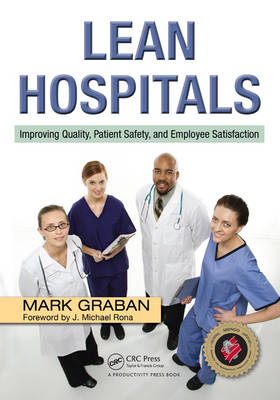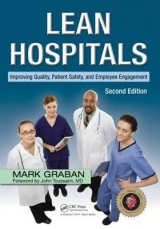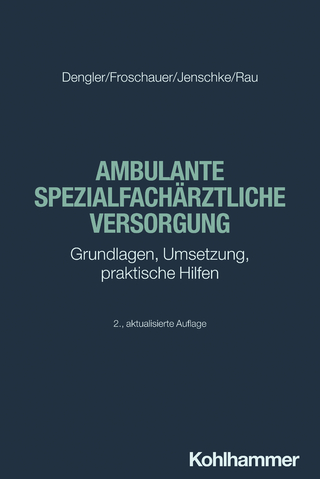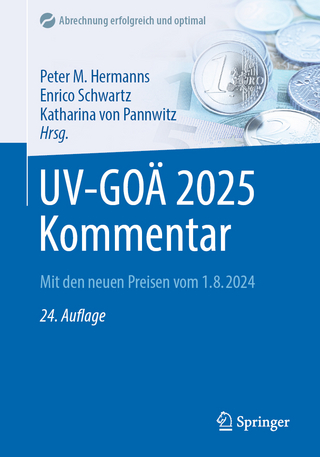
Lean Hospitals
Productivity Press (Verlag)
978-1-4200-8380-4 (ISBN)
- Titel erscheint in neuer Auflage
- Artikel merken
Winner of a 2009 Shingo Research and Professional Publication Prize
Drawing on his years of working with hospitals, Mark Graban explains why and how Lean can be used to improve safety, quality, and efficiency in a healthcare setting. After highlighting the benefits of Lean methods for patients, employees, physicians, and the hospital itself, he explains how Lean manufacturing staples such as Value Stream Mapping and process observation can help hospital personnel identify and eliminate waste in their own processes — effectively preventing delays for patients, reducing wasted motion for caregivers, and improving the quality of care.
Additionally, Graban describes how Standardized Work and error-proofing can prevent common hospital errors and details root cause problem-solving and daily improvement processes that can engage all personnel in systemic improvement. A unique guide for healthcare professionals, Lean Hospitals clearly elaborates the steps they can take to begin the proactive process of Lean implementation.
The book has an accompanying website with more information.
Mark Graban was quoted in a July 2010 New York Times article about lean hospitals.
*Given the increase in candidates from the health services sector, the Lean Certification and Oversight Appeals committee has approved Lean Hospitals by Mark Graban as recommended reading in pursuit of the Lean Bronze Certification exam.
Mark Graban speaks about his book on the CRC Press YouTube channel.
Mark Graban is the Director of Communications and Technology for the Healthcare Value Leaders Network.
The Case for Lean Hospitals
Why Do Hospitals Need Lean?
Lean Methods Are Not New to Healthcare
Toyota’s Role in Popularizing Lean
Origins of the Term Lean
Lean Is Proven to Work Outside of Automotive Factories
Lean Is Helping Hospitals Improve
Problems in Healthcare
Price Pressures and Cost Challenges
Coping with Employee Shortages
Poor Quality of Care
Good Quality Costs Less
A Snapshot of Department Success
A Snapshot of Hospital Success
Conclusion
Lean Lessons
Ponder
Notes
Overview of Lean for Hospitals
What Is Lean?
Ohno’s Definition of Lean
Lean Thinking
The Toyota Triangle: Tools, Culture, and Management System
Human Development
Philosophy
Technical Tools
Managerial Methods
Lean Is about Reducing Waste and Respecting People
Elimination of Waste
Respect for People
Fixing Healthcare from the Inside
Capability 1: Work Is Designed as a Series of Ongoing Experiments That Immediately Reveal Problems
Capability 2: Problems Are Addressed Immediately through Rapid Experimentation
Capability 3: Solutions Are Disseminated Adaptively through Collaborative Experimentation
Capability 4: People At All Levels of the Organization Are
Taught to Become Experimentalists
Conclusion
Lean Lessons
Points to Ponder
Notes
Value and Waste
What Is Waste?
What Is Value? Start with the Customer
How Do We Define Value?
Rule 1: The Customer Must Be Willing to Pay for the Activity
Rule 2: The Activity Must Transform the Product or Service in Some Way
Rule 3: The Activity Must Be Done Right the First Time
Examples of Value-Added and Non-Value-Added Activities
Learning to Identify and Describe Waste
Waste of Defects
Waste of Overproduction
Waste of Transportation
Waste of Waiting
Patients and Products Waiting
Employees Waiting
Waste of Inventory
Waste of Motion
Waste of Nursing Motion
Waste of Overprocessing
Waste of Talent
What Non-Value-Added Activities Are Required?
Non-Value-Added, Pure Waste
Conclusion
Lean Lessons
Points to Ponder
Notes
Observing the Process and Value Streams
How Do We Find Waste?
What Is a Value Stream?
Value Stream Mapping
Creating a Value Stream Map
Observing the Process
Activity of the Product
Activity of the Product—Laboratory
Activity of the Employee
Activity of the Employee—Nursing
Activity of the Employee—Perioperative Services
Conclusion
Lean Lessons
Points to Ponder
Notes
Standardized Work as a Foundation of Lean
The Need for Standardized Work
The Toyota House Metaphor
Overview of the Lean Foundations
Lean Foundations: Standardized Work
Definition of Standardized Work
"Current"
"Proper Outcome and the Highest Quality"
"To Safely Complete"
"One Best Way"
Standardized, Not Identical
Written by Those Who Do the Work
Considering How Long Tasks Take
Types of Standardized Work Documents
Standardizing Daily Routines
Defining Roles and Responsibilities
Explaining Why through Standardized Work
Standardized Work Documents and the Standardized Work System
Measuring and Observing for Standardized Work Adherence
Resistance to Standardized Work
Asking Why When Standardized Work Is Not Being Followed
Standardized Work Can Apply to Physicians
Another Example of Having to Ask Why
Training through Standardized Work
Conclusion
Lean Lessons
Points to Ponder
Notes
Lean Methods: Visual Management, 5S, and Kanban
Lean Is More Than Tools, but Tools Can Help
Reducing Waste through Visual Management
Examples of Visual Management
5S: Sort, Store, Shine, Standardize, and Sustain
First S: Sort
Second S: Store
Third S: Shine
Fourth S: Standardize
Fifth S: Sustain
Safety as a Sixth S?
Kanban: A Lean Approach to Managing Materials
Problems with Traditional Materials Systems
Trade-offs with Inventory
Using Kanban within a Department
A Kanban Case Study
Conclusion
Lean Lessons
Points to Ponder
Notes
Proactive Root Cause Problem Solving
Improving Quality and Patient Safety
Cultural Obstacles to Quality Improvement
Why Do Errors Occur?
Examples of Quality Improvement
Finding Root Causes and Preventing Errors
Workarounds and the Need for Fixing Root Causes
Asking "Why?" Instead of "Who?"
Start at the Gemba
The Five Whys Method
Example of the Five Whys: Hand Hygiene
Be Proactive and Use FMEA
Proactive Resolution of Near-Miss Problems
The Safety Pyramid
Conclusion
Lean Lessons
Points to Ponder
Notes
Preventing Errors
Creating Quality at the Source through Error Proofing
Being Careful Is Not Enough
Why 100% Inspection Is Not 100% Effective
Types of Error Proofing
Make It Impossible to Create the Error
Make It Harder to Create the Error
Make It Obvious the Error Has Occurred
Make the System Robust, So It Tolerates the Error
Error Proofing, Not Dummy Proofing
Examples of Error Proofing in Hospitals
Banned Abbreviations as Error Proofing
Computer Systems as Error Proofing
Preventing Surgery Errors through Error Proofing
Stopping the Line (Andon)
Error Proofing the Error Proofing
Conclusion
Lean Lessons
Points to Ponder
Notes
Improving Flow
Processes Should Flow Like a River
Uneven Workloads as a Barrier to Flow
Naturally Occurring Unevenness
Mura Caused by Morning Rounds
Mura Caused by Suboptimizing Courier Routes
Mura Created by Clinic Scheduling
Mura in the Patient Discharge Process
Addressing Mura by Matching Staffing to Workloads
Improving Patient Flow
Improving Patient Flow in the Emergency Department
Improving Patient Flow in Outpatient Cancer Treatment
Improving Flow for Patient Care and Support
Improving Flow in Clinical Laboratories
Reducing Delays in Specimen Collection
Reducing Delays in the Lab’s Receiving Areas
Improving Flow Also Improves Quality and Teamwork
Reducing Delays Inside the Lab’s Testing Areas
Improving Flow in Pharmacies
Conclusion
Lean Lessons
Points to Ponder
Notes
Engaging and Leading Employees
Changing How We Manage
What Is a Manager’s Role?
Common Management Problems
Lean as a Management System and Philosophy
A Daily Lean Management System
Process Audits or Rounding
Standardized Audits of the Standardized Work
A Hierarchy of Audits
Performance Measures
Timely Measures Drive Improvement
A Balanced Scorecard Focuses on All Stakeholders
Metrics Should Be Visible, Visual, and Statistically Meaningful
Daily Stand-up Team Meetings
Kaizen and Suggestion Management
Problems with Suggestion Boxes
The Role of Supervisors in Kaizen
Finding a Better Method for Managing Kaizen
Visual Tracking of Suggestions
Communicating Kaizen Changes
Conclusion
Lean Lessons
Points to Ponder
Notes
Getting Started with Lean
Where Do We Start?
Types of Kaizen
Kaizen Events
Pitfalls of Kaizen Events
Lean Transformation
Executive Sponsorship and Leadership
Starting from the Middle
Establishing a Model Line and a Roadmap
Chartering a Project
Dedicating Internal Resources: The Lean Team
The Importance of Change Management
The Beginnings of a Lean Enterprise
Starting in the Lab
Moving to Other Areas
Designing a Hospital for Lean
Designing a New ED Process for the New Space
The Future Roadmap
Conclusion
Lean Lessons
Points to Ponder
Notes
A Vision for a Lean Hospital
When Is a Hospital Lean?
What Would a Lean Hospital Look Like? What Would a Patient Experience in a Lean Hospital?
What Would It Be Like to Work in a Lean Hospital?
How Would We Describe a Lean Hospital?
Strategy and Management System
Patients
Employees
Waste and Kaizen
Technology and Infrastructure
Final Thought
| Erscheint lt. Verlag | 23.7.2008 |
|---|---|
| Zusatzinfo | 9 Halftones, black and white; 23 Tables, black and white; 41 Illustrations, black and white |
| Verlagsort | Portland |
| Sprache | englisch |
| Maße | 178 x 254 mm |
| Gewicht | 499 g |
| Themenwelt | Medizin / Pharmazie ► Gesundheitswesen |
| Wirtschaft ► Betriebswirtschaft / Management | |
| ISBN-10 | 1-4200-8380-5 / 1420083805 |
| ISBN-13 | 978-1-4200-8380-4 / 9781420083804 |
| Zustand | Neuware |
| Haben Sie eine Frage zum Produkt? |
aus dem Bereich



